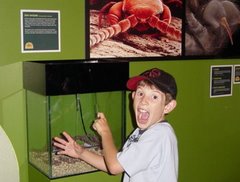Have been reading some sites looking at trends in the web world for 2008 (thanks mostly to Russ and Phil). Here’s what I’ve learned and how I think these trends apply to museums.
1. The rise of mobile technologies: Does this mean museum websites will need to operate on a range of mobile platforms? Do we encourage content from people wherever they happen to be? There is enormous potential I see for fieldwork/fieldguides that are updated live by people who are actually there researching/seeing the world as it happens - just one idea, I’m sure there are heaps of others.
2. Archiving: How to archive the massive amounts of information that not only comes via email, but posted on sites such as MySpace and Facebook. How do you archive work-related conversations, posts, links etc, that are starting to amass on these sites? I strongly believe that good old paper is the way to go (just reinforced as I re-read Plutarch’s Fall of the Roman Republic preserved for all that time on paper...)
3. E-learning tools are more accessible and easy to use: Larry Ferlazzo’s website lists the 14 best web applications for education. Many of these could be used by museums in their online learning programs, or at least stream content to them somehow?
4. Organisational issues: “Managers [and employees?] will need to be more creative and less obsessed with cost and efficiency” and “Stop competing against your competitors [as] your traditional rivals aren’t your biggest worry” – these come from BusinessWeek’s Innovation Predictions 2008. There a many lessons for museums in working together which is often easier to do in the online world. Bigger funding pots will come from partnership programs in the future I believe. The skills that I posted here about Knowledge Workers could form part of a checklist for future organisational development? The McKinsey Quarterly eight trends to watch article also has a wealth of insights into organisational issues and the web.
5. Collaboration: The Guardian’s Top 10 trends for 2008 include interesting insights into how companies will collaborate more with their online users and work differently with them. Museums have the opportunities to tap into a huge resource of “armchair experts” to add rich content and commentary to their online offerings – have a look at the article Open Source Science which discussed this some time ago. Not a new idea I know but the tools of the web will enable collaboration to be undertaken more easily, quickly and efficiently (and cheaply!!). The McKinsey article also discusses this issue and provides an example of Amazon enabling other businesses to use its services and in turn reaps the benefits of new applications and developments.
6. The rise of co-creation and (I also think) of an informed and active citizenry on a global scale: Nina Simon’s post outlines a challenge for co-creation to find the right questions. She references this wonderful site – The World Question Centre. Will co-creation become the new buzz term replacing social media and Web 2.0? I have also posted a range of links on my del.icio.us site of organisations that are ones to look out for in terms of active citizenry. You can search for them using the tag “climatechangeARC”.
7. Mash-ups: Now I understand what this term means couldn’t help but use it! The McKinsey article discusses data integration under Managing capital and assets as part of “leveraging information in new ways”. For museums the challenge will be to store and share data – will we have the courage and foresight to insist on using tools and systems that will enable easy data sharing across our institutions?
8. Search, analytics and measurement will become increasingly important: CMS Watch’s Twelve Predictions for 2008 discusses this (as well as several other gems). We are seeing discussions about user-led searching, particularly with the Powerhouse Museum’s OPAC 2.0 (here’s the most recent blog post about it, trackback from there for more). There are also useful discussions about web analytics on Seb’s blog. Museums will need to get serious and go beyond measuring numbers to detailing interactions and experiences – something that audience researchers have successfully moved to in looking at visitors’ physical experiences. Perhaps a future new role for those of use working in this field?
9. Gadgets and gizmos: Have a look at the Sydney Morning Herald and BBC websites. I want a Chumby!
10. Finally, again from CMS Watch which is worth reproducing in full here: “What should you do? Keep focussed on specific business objectives. Someone in your enterprise should be thinking about The Next Big Thing, but not at the expense of undertaking the hard work of real information and process analysis today.” As mentioned in an earlier post, Peter Drucker discussed these ideas in his book Managing in Turbulent Times (which on re-reading is so relevant to today even though it was written in 1980!).
I know there are many more so feel free to add your thoughts.
Wednesday, January 09, 2008
Subscribe to:
Post Comments (Atom)



6 comments:
On the issue of mobility check out this post about the OLPC XO laptop.
On the issue of data sharing, social networking and collaboration go to this blog post about Facebook and museum objects.
Thanks for sharing my list of web applications for education with your readers!
Here's another nice site relating to education and Web 2.0, with a useful reflective piece about Web 2.0 in the classroom: Transitioning to Web 2.0
Great post about museums and social networks.
Just came across this article about quick response codes. Seems like a technology we could be using in our exhibitions in future??
Post a Comment